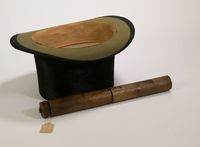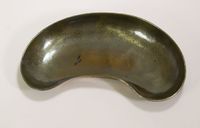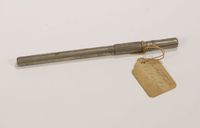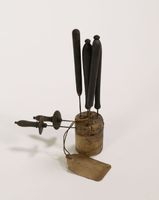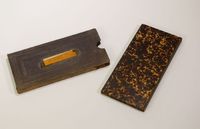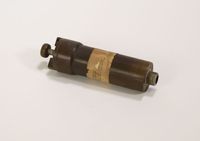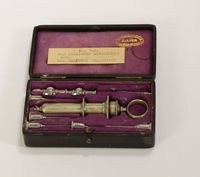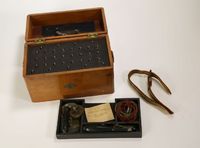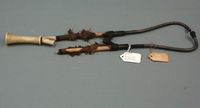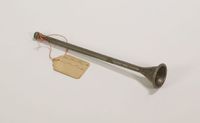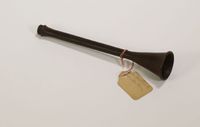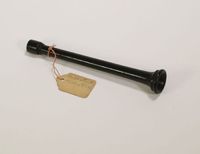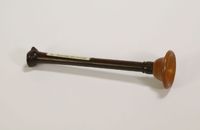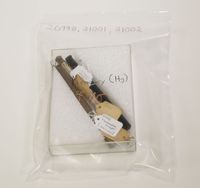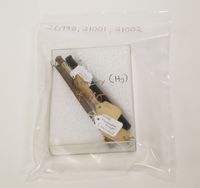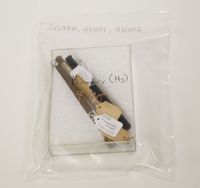Frederick and George Cheever Shattuck Collection, 1847-1929. WAM 20098, 21001, 21002, 21088, 21093, 21095-21097, 22200-22209, 22247.
Dublin Core
Title
Frederick and George Cheever Shattuck Collection, 1847-1929. WAM 20098, 21001, 21002, 21088, 21093, 21095-21097, 22200-22209, 22247.
Subject
Surgical Instruments
Thermometers
Stethoscopes
Syringes
Otolaryngology
Polygraph Machine
Shattuck, Frederick Cheever, 1847-1929
Shattuck, George Cheever, 1879-1972
Description
Frederick Cheever Shattuck was born on November 1, 1847, in Boston, Massachusetts. He came from a long line of doctors, including his father, George Cheyne Shattuck, Jr. (1813-1893) and his grandfather George Cheyne Shattuck (1783-1854). This lineage dates back to William Shattuck (1622-1672), who was an early Puritan settler in Watertown. After completing his medical degree at Harvard Medical School in 1873, Frederick Cheever Shattuck traveled across Europe to visit major hospitals and attend lectures. Upon his return to Boston in 1875 he set up a private practice, but did not see immediate success. He joined the Harvard Medical School faculty in 1879, where he was appointed Clinical Instructor in Auscultation and Percussion. He became the Jackson Professor of Clinical Medicine in 1888 and held the position until his retirement in 1912. During this time, Shattuck also became Chief of Medical Staff at Massachusetts General Hospital. After his retirement he joined the Board of Overseers of Harvard College. He served on the Board from 1913 to 1919. Shattuck was a member of the Faculty Committee on the Course of Study from 1898-1909. While on this committee, he saw deficits in both the lack of consistency in visiting physician rotations at the local hospitals and the lack of consistency and communication between the Medical School’s departments of Clinical Medicine and the Theory and Practice of Physic. His work with the Committee on these problems led to a massive shift in how Harvard Medical School organized its programs and interacted with the local hospitals, which resulted in the affiliate hospital system that the school has today. When the Medical School proposed establishing a Department of Tropical Medicine in 1913, Shattuck quickly raised the funds. Before the end of the department’s five year trial period, he endowed the Chair of Tropical Medicine himself to ensure the permanence of the department. In 1916, Shattuck collected a fund to promote public health initiatives amongst workers. He became the Chairman of the Committee on Industrial Hygiene, which distributed the fund. The success of this endeavor had a large influence on the establishment of the Harvard School of Public Health. Frederick Cheever Shattuck died at his home in Brookline on January 11, 1929.
George Cheever Shattuck was born October 12, 1879. After completing his medical degree at Harvard Medical School in 1905, Shattuck embarked on a world tour and ended up stopping for several months to work with Richard P. Strong (1872-1948) at the latter’s laboratory in the Philippines. After his time in the Philippines, Shattuck undertook additional clinical training in Vienna, Austria, and then returned in 1908 to Harvard Medical School. When the Department of Tropical Medicine was formed at the Medical School in 1913, Shattuck was recruited as a faculty member. In 1916, the American Red Cross organized a medical commission to travel to Serbia to assist Serbian physicians in controlling an epidemic of typhus. Shattuck, Richard P. Strong, Hans Zinsser, and A. Watson Sellards were all members. Shattuck was responsible for the examination of post-mortem evidence and performed numerous autopsies, collating the data for the commission’s final report, published in 1920. From 1917 to 1919, Shattuck served with the Harvard Surgical Unit embedded with the British Expeditionary Force; after the armistice that ended World War I, he served in Switzerland as General Medical Secretary of the League of Red Cross Societies. Shattuck returned to Boston in 1921 as assistant professor of tropical medicine at Harvard Medical School and worked to establish a service for tropical medicine at Boston City Hospital. In 1924-1925, Shattuck accompanied the Hamilton Rice expedition to the upper Amazon in Brazil. He co-led a medical survey expedition with Richard P. Strong to Liberia and the Belgian Congo in 1926-1927. Between 1929 and 1932, Shattuck led three expeditions funded by the Carnegie Institute to identify health problems in the Yucatan and Guatemala. Shattuck was elected president of the American Society of Tropical Medicine in 1927; the Society awarded him the Theobald Smith Medal in 1954 and the Richard Pearson Strong Medal in 1962. He was also a member of the American Academy of Tropical Medicine and the Royal Society of Tropical Medicine and Hygiene. Shattuck died in 1972.
The majority of these instruments in this collection were removed from the office of Frederick Cheever Shattuck shortly after his death in 1929. This included a number of monaural stethoscopes that Cheever had collected. George Cheever Shattuck added a few of his own objects to this donation, including a polygraph machine and a dry cell battery.
George Cheever Shattuck was born October 12, 1879. After completing his medical degree at Harvard Medical School in 1905, Shattuck embarked on a world tour and ended up stopping for several months to work with Richard P. Strong (1872-1948) at the latter’s laboratory in the Philippines. After his time in the Philippines, Shattuck undertook additional clinical training in Vienna, Austria, and then returned in 1908 to Harvard Medical School. When the Department of Tropical Medicine was formed at the Medical School in 1913, Shattuck was recruited as a faculty member. In 1916, the American Red Cross organized a medical commission to travel to Serbia to assist Serbian physicians in controlling an epidemic of typhus. Shattuck, Richard P. Strong, Hans Zinsser, and A. Watson Sellards were all members. Shattuck was responsible for the examination of post-mortem evidence and performed numerous autopsies, collating the data for the commission’s final report, published in 1920. From 1917 to 1919, Shattuck served with the Harvard Surgical Unit embedded with the British Expeditionary Force; after the armistice that ended World War I, he served in Switzerland as General Medical Secretary of the League of Red Cross Societies. Shattuck returned to Boston in 1921 as assistant professor of tropical medicine at Harvard Medical School and worked to establish a service for tropical medicine at Boston City Hospital. In 1924-1925, Shattuck accompanied the Hamilton Rice expedition to the upper Amazon in Brazil. He co-led a medical survey expedition with Richard P. Strong to Liberia and the Belgian Congo in 1926-1927. Between 1929 and 1932, Shattuck led three expeditions funded by the Carnegie Institute to identify health problems in the Yucatan and Guatemala. Shattuck was elected president of the American Society of Tropical Medicine in 1927; the Society awarded him the Theobald Smith Medal in 1954 and the Richard Pearson Strong Medal in 1962. He was also a member of the American Academy of Tropical Medicine and the Royal Society of Tropical Medicine and Hygiene. Shattuck died in 1972.
The majority of these instruments in this collection were removed from the office of Frederick Cheever Shattuck shortly after his death in 1929. This included a number of monaural stethoscopes that Cheever had collected. George Cheever Shattuck added a few of his own objects to this donation, including a polygraph machine and a dry cell battery.
Collection Items
View all 19 itemsCollection Tree
- Warren Anatomical Museum
- Frederick and George Cheever Shattuck Collection, 1847-1929. WAM 20098, 21001, 21002, 21088, 21093, 21095-21097, 22200-22209, 22247.


